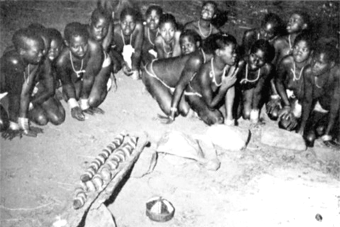| |
Phuse
When I asked for the meaning of phuse, I was always told,"phuse is phuse"! The word may be derived from -phusa = to wean a calf, and thus refers to the novices' final separation from childhood. Phuse looks like that which Stayt (1931:117) calls sali. Stayt says that the base was made of ashes, earth and cow dung, whose colours would presumably symbolize men, women, and old ladies: but my informants insisted that this would be done only if clay was not available. Seeds of white, red, yellow and black maize (see colour symbolism) are placed on a small dome of clay, so as to form coloured sections, and an ostrich feather is stuck on top. While phuse is shown, they sing Domba Song No. 6.
|

Three clay models are uncovered at the same time and shown to the novices. From left to right they are  haru (the python), khovhe-ya-vhimbi (the sea serpent, or eel), and phuse. Phuse is decorated with red, white and black grains of maize, and the other two with paint of the same colours. haru (the python), khovhe-ya-vhimbi (the sea serpent, or eel), and phuse. Phuse is decorated with red, white and black grains of maize, and the other two with paint of the same colours. |
The sense of this is that it takes a long time for a girl to become fully nubile. The moon is, of course, associated with the onset of the menses. One master said that it should be nnyangawe, an abbreviation of nnyo ya nga iwe (your genitals).
Lesson
Only milayo are given. These are the same as those for colours and feathers (see, for example Nos. 215-217, 200, 201, and 241-243). Parts of the feather symbolize potency, impotence, and the legs of a millipede. |
|